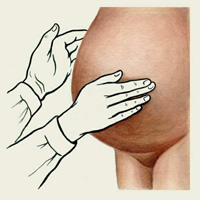Normally in the abdominal cavity contains a small amount of transparent fluid. With various diseases in the abdomen, liquid accumulates. Clinically ascites manifests itself a significant increase in abdomen in volume.
Content
The concept of ascite
Normally in the abdominal cavity there is a very slight amount of transparent liquid that provides «slip» peritoneal leaflets lining internal organs and restricting the abdominal cavity itself. With various diseases, it is possible to appear different types of abdominal liquids. It may be blood with intra-abdominal bleeding due to traumatic damage to internal organs, gynecological diseases (rupture of the ovary cysts, ectopic pregnancy); Purulent-inflammatory liquid, as the result of acute inflammation of the peritoneum in acute appendicitis, cholecystitis, intestinal obstruction, stomach sample ulcers, etc. In such clinical situations, the number of contents usually does not exceed 2-3 liters and, therefore, visually increasing the abdomen is practically not fixed with the primary examination of the patient. The presence of fluid in the abdominal cavity is determined by using special techniques of percussion and palpation, as well as with instrumental examination (ultrasound, laparoscopy).
The formation of ascitic syndrome, that is, the pathological accumulation of fluid from a small volume to several tens of liters, usually happens much slower. The reason for its occurrence is a number of diseases that sometimes have completely dissimilar laws of development.
The main reasons for the development of ascites
 Diseases complicated by chronic progressive decompensation of the pump function. Here are the consequences of the previously suffered (transferred) myocardial infarction, congenital and acquired valve flaps, the failure of the heart muscle against the background of acute or chronic inflammatory, toxic lesion (myocarditis), heavy diseases of the respiratory system, in which the right heart departments are forced to overcome resistance due to hypertension in a small circulation circle. In all such clinical situations, the outflow of venous blood from the liver to the heart is hampered, which, ultimately, leads to the rising of its liquid part in the abdominal cavity. Very often, these patients define signs of anasarki - the accumulation of the same liquid in the cardiac shirt, pleural cavities, accompanied by severe swelling of soft tissues.
Diseases complicated by chronic progressive decompensation of the pump function. Here are the consequences of the previously suffered (transferred) myocardial infarction, congenital and acquired valve flaps, the failure of the heart muscle against the background of acute or chronic inflammatory, toxic lesion (myocarditis), heavy diseases of the respiratory system, in which the right heart departments are forced to overcome resistance due to hypertension in a small circulation circle. In all such clinical situations, the outflow of venous blood from the liver to the heart is hampered, which, ultimately, leads to the rising of its liquid part in the abdominal cavity. Very often, these patients define signs of anasarki - the accumulation of the same liquid in the cardiac shirt, pleural cavities, accompanied by severe swelling of soft tissues.
Oncological diseases of various location, including the abdominal organs, more often in the terminal stage. Due to the extensive propagation of tumor cells on a lymphatic system, which determines the required volume of outflow of the liquid from the abdominal cavity, the drainage function of lymphottock becomes insolvent. In addition, often in such patients there is a specific lesion of liver tissue with metastases, which also favors the accumulation of liquid in the abdominal cavity. It should be noted that remote metastases in the liver may occur during localization of a malignant tumor far beyond the abdominal cavity (lung cancer, mammary glands, melanoma of the skin, etc.). Of great importance is sharply pronounced protein failure against the background of cachexia.
Terminal phase of chronic renal failure caused by a variety of congenital and acquired diseases (polycystic, hypoplasia; tumors, tuberculosis, urolithiasis, pyelonephritis, glomerulonephritis, etc.) kidneys and their toxic damage (poisoning of heavy metal salts, acetic acid, complication of blood transfusion, etc.).
Acute and chronic liver diseases caused by its viral or toxic lesion (hepatitis, cirrhosis).
«Others» Rarely encountered clinical situations (injuries of trunk trunks, malformations of the lymphatic system, lymphogranulomatosis, amyloidosis, mesothelioma peritoneum).
Symptoms of ascites
The appearance of ascites in a patient suffering from a liver disease is always an unfavorable sign. This kind of complication significantly worsens the forecast. Ascicitis syndrome may appear and progress rather quickly, and it can manifest with imperceptibly with a much slower pace of its development. Depending on the amount of fluid in the abdominal cavity and the flow of the flow of syndrome, the ascites are classified as follows.
If the amount of fluid is small (up to 2-3 l) and is determined only with the instrumental (most often ultrasound or laparoscopic) study, as well as a targeted medical examination, ascites are called small. The presence of a small amount of sterile liquid in the stomach is usually not accompanied by symptoms.
If the amount of fluid is greater, the abdomen configuration changes («frogsychy», «melted», «round»), but there is no sharp stretching of the fabrics of the anterior abdominal wall, and there are no signs of difficulty tours of the diaphragm, then such ascites are classified as medium.
With even greater accumulation (up to 20-30 liters or more), the stomach fluid becomes huge, making it difficult to move the patient, respiratory movements, makes it makes a forced position on the side during sleep, in order to facilitate the state. This condition is regarded as a big ascite.
Depending on the change in the amount of contents in the abdomen, which can vary at different stages of the course of the liver cirrhosis, ascites are divided into transient, stationary and resistant.
Transient call ascites, which is often combined with «Malaya» Form. It is detected: a) when ultrasound or computed tomography, b) during diagnostic laparoscopy, c) with a directed physical (percussion, palpation) of the patient's study. It disappears against the background of a conservative treatment carried out in parallel with the improvement of the patient's condition forever, either before the period of the next exacerbation of the pathological process, which leads to the decompensation of bloodlag-eyed in the liver, providing adequate water balance in the body.
If the appearance of the liquid in the stomach is not an episode, some amount of fluid in the abdominal cavity is preserved, despite adequately conducted therapy, such ascites belong to the category of stationary.
Depending on the number of contents in the abdominal cavity, it is subdivided:
- small
- average
- large
A large ascite that fails not only to stop, but also to reduce quantitatively even using large doses of diuretic drugs, is called resistant (trapid, refractory).
If the accumulation of fluid continues to grow steadily and reaches huge sizes, despite the treatment, such ascites are called intensive.









